By match reporter Wouter Sipma
The first victory has been won (already? only?) on the second day of the match. The classical game in the morning ended in a draw, but in the rapid session of four games the spell was broken: Jan Groenendijk defeated Guntis Valneris in the third round and won this session: 5-3. In the second and fourth game Groenendijk had big chances as well, making his lead in rapid a well-deserved one.
Classical game
The classical game in the morning was interesting: an edge piece game arose from the Chogoliev opening, which virtually guarantees attractive play. Again the early middle game drained both players’ time, forcing them to decide quickly in the decisive phase of the game. In diagram 1 the clock indicated less than 10 minutes of thinking time for both players.
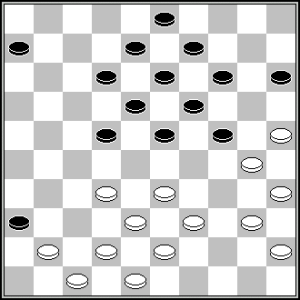
Now Groenendijk has a choice to make: 41-37 or 42-37. Black has a nice centre and it is white’s task to keep some play on his left wing and in the meantime activate the pieces on 40 and 45. In this case it is clear that 25. 42-37 is not preffered. After 25. … 12-17 26. 39-34 24-29(!) 27. 33×24 14-20 28. 25×14 9×29 white has no means of successfully undermining piece 29. For instance, the apparent forcing 29. 43-39 22-28 (also 29. … 8-12 is possible) 30. 48-43(??) fails. White threats to play 30-24 etc., but black wins: 30. … 28-33! 31. 39×28 18-22+.
Thus Groenendijk played 25. 41-37 6-11 and now had to think again: how to value 26. 39-34? In this case the 2-for-2 exchange 24-29, 14-20 is less of a problem, since white is more compact. The critical variant is 26. … 14-20 27. 25×14 9×20 28. 32-27 (28. 30-25?? 24-30!+) 22×31 29. 37×26. It may see logical for black to take the short wing lock with 29. … 20-25(?), but this actually plays into the hands of white. The black occupation of squares 36 and 24 together with the open square 14 enables white to bring effective tactics into play after 30. 42-37(!) (dear reader, please examine 30. 33-28?! 23×32 31. 38×27 as well!), followed by 31. 37-32(!). To get rid of the shot 47-41 (36×47) 32-28 (23×32) 38×27 (47×29) 34×14 (25×34) 40×20 (15×24) 14-10 etc., black needs to play the weak 15-20 and this structure cannot be good.
Groenendijk however dropped 26. 39-34 because of (26. … 14-20 27. 25×14 9×20 28. 32-27 22×31 29. 37×26) 29. … 3-9(!) (the hole on 14 needs tob e closed). Now black will always play 9-14 on the next move, creating a strong centre block. Also after 30. 30-25 9-14 white stands empty-handed: 31. 34-29? 23×34 32. 40×29 simply loses a piece after 32. … 19-23.
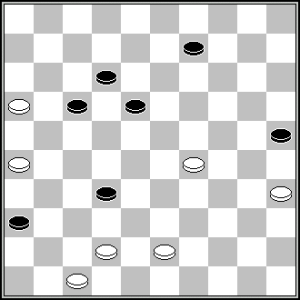
The game was continued with 26. 32-27 22×31 27. 37×26 12-17 28. 33-28 23×32 29. 38×27 24-29. Also after 30. … 17-22, white keeps acceptable play, he will not lose the fight for control on his left wing. 30. … 18-22(?) 31. 27×18 13×22 is worse for black; after that he will not be able to reach square 23 because of the white Olympic formation, making the black pieces shatter onto the white structure. For me it was quite clear that the position in the game after 30. 40-34 29×40 31. 45×34 was more or less equal; in the meantime all white pieces came into play, but also black does not have any weaknesses. The players spiced up the game with mutual sharp moves in a final stage marked by time shortage, but the balance was not disturbed.
In diagram 2 Groenendijk forced a clear draw: 45. 26-21(!) 17×26 46. 16-11 32-37 47. 42×31 26×37 48. 11-6 37-41 49. 29-23! and hands were shaken without playing 49. … 18×29 50. 6-1 12-17 51. 1×45 after which white will recover his lost piece.
Rapid (4 games)
The first rapid game started promising with a fork lock for Groenendijk after a non-standard opening. The fork lock remained on the board fors ome time, but in a 14-vs-14 position Valneris initiated a large scale exchange of pieces (because he had limited belief in keeping up the tensions?), causing the game to fizzle out: a draw.
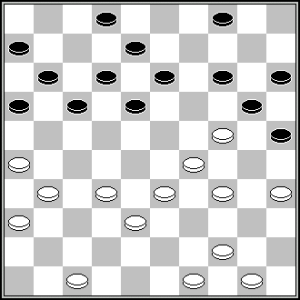
The rapid session was continued with a game which was exciting until the end. From the opening a battle of attack versus surrounding arose, in which Groenendijk got the better chances in the (late) middle game. Valneris managed however to defend outstandingly and reached an endgame of a king and three pieces for him against two kings and two pieces for Gronenendijk. Groenendijk’s pieces were located in the centre of the board, enabling Valneris to swiftly capture one of these thus forcing a draw.
In the third rapid game Valneris chose a somewhat provocative opening (1. 34-30 20-25 2. 30-24 19×30 3. 35×24 18-22 4. 33-29 14-20 5. 39-34?!), which has been played a few times for example by Pim Meurs.
Things quickly turn bad for Valneris in diagram 3 after 26. … 4-9(!) 27. 44-39? (here a configuration with 27. 50-45(!) 2-7 28. 45-40(!) seems needed) 2-7! 28. 32-28* 17-22! 29. 28×17 12×21 30. 26×17 11×22, see diagram 4.
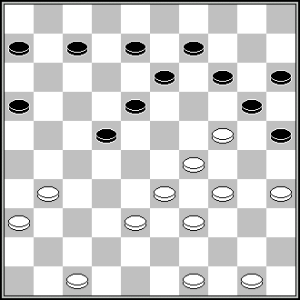
Here it is important dat 31. 38-32 is met by the ‘impossible move’ 31. … 16-21!, threatening 21-26, while 31-27 and 32-28 are no options, just as 32. 31-26(?) 21-27! 33. 32×21 22-27 34. 21×32 18-23 35. 29×18 20×27+. 31. 49-43(?). Perhaps it was better to still bring piece 50 to 40, although black can build a strong blockade by 16-21-27. In the game the blockade worked even better, white can never play 38-32 anymore: 31. … 14-19(!) 32. 50-45 19×30 33. 35×24 16-21! 34. 47-42 21-26! 35. 42-37 9-14 36. 45-40 7-11 37. 40-35 11-16 and for Valneris only remained to give up. A neat piece of surrounding work by Groenendijk!
Valneris chose for a surrounding himself in the last game of the day, but soon had to come back to that. After that, Groenendijk had visibly a nicer position; Valneris however cleverly managed to create some counterplay. But in diagram 5 he made a mistake.
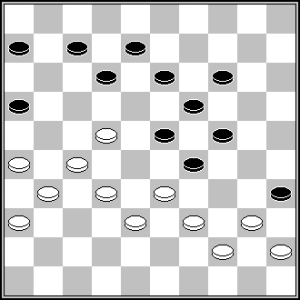
White’s short wing does not look nice and after 39. … 14-20 (!) black probably has better chances. Valneris however played 39. … 12-18? after which Groenendijk struck with 40. 32-28! 23×34 41. 22-17 29×38 42. 40×9 13×4 43. 27-21 16×27 44. 31×11. In the remaining endgame Groenendijk probably did not use his best chance and Valneris was able to save the game; it is up to the computer programs to determine whether in this endgame an analytical win was within reach for Groenendijk.
Conclusion after day 2: an exciting classical game proved to be an omen for the upcoming rapid games, in which a lot happened, often with little time on the clock for both players. Groenendijk handled this undisputedly stronger and got chances in the last three games, of which he managed to capitalize one.
Valneris will be eager to hit back tomorrow; if he does not succeed in the classical game, then he will still have chances in ten blitz games in the afternoon! Another interesting question is: will the players adjust their time usage? In all games so far already in the middle game both players suffer time shortage; so a bit of tuning can surely be done..